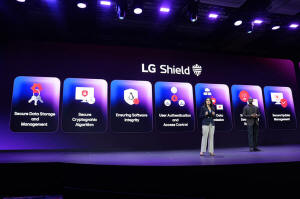Entertainment leaders amp up discussions about AI, creators and
innovative tech at CES 2026
[January 07, 2026]
By KAITLYN HUAMANI
LAS VEGAS (AP) — The world’s largest tech showcase does not come without
theatrics. Innovations and gadgets like a lollipop that sings to you as
you consume it, a laundry-folding robot and a “smart” LEGO brick have
stolen the spotlight so far at CES 2026. But underscoring this year’s
programming is a strong focus on an industry that relies on a similar
theatrical flair: entertainment.
More than 25 different panels and events related to the entertainment
industry are on the schedule in Las Vegas, focusing on both the
traditional studio side of the industry and the digital side driven by
content creators. The programming has posed questions about the
cinematic capabilities of AI, how advertising has been impacted by AI
and the role the burgeoning creator economy plays in the larger
entertainment landscape.
Artificial intelligence has long been a sticking point in Hollywood, and
many creatives in the entertainment world have been reluctant to embrace
the rapidly evolving technology and AI-powered tools. Outrage ensued
when Tilly Norwood, an entirely AI-made character, debuted as the first
“AI actor” in the fall. Questions about copyrighted characters, images
and materials still loom large in conversations about AI. But many
speakers in CES programming were optimistic about how the technology can
be beneficial, and how AI could be used to help artists harness their
creativity rather than stifle it or replace it.

“The tools that we create have unlocked something in us. It’s kind of
flattened that bar in terms of what storytelling can be because anyone
now can be a storyteller,” said Dwayne Koh, the head of creative at
Leonardo.ai, during a Monday session on AI and creativity. “It levels
the playing field, but it also makes it easier for people to tell
stories that they always want(ed) to tell that they never could have the
opportunity to tell.”
Others were quick to point out that Hollywood’s panic over emerging
technology is not new.
“When we launched Photoshop in the ’90s, we were also getting pretty
angry phone calls from creatives saying that we were destroying craft,”
said Hannah Elsakr, Adobe’s vice president of generative AI new business
ventures, at a Monday session focused on advertising.
“We’re in early days with AI. I’m not advocating for more cats jumping
off diving boards in your feeds. I think it’s about high creativity and
so the director, the artist, the actor is going to drive the high
quality,” Elsakr continued. “Think of AI as another tool in the toolkit
to make you drive that forward.”
[to top of second column]
|

Angela Gozenput of home appliances and solution marketing and Aaron
Westbrook of media entertainment and solution marketing, talk during
an LG Electronics news conference ahead of the CES tech show Monday,
Jan. 5, 2026, in Las Vegas. (AP Photo/Abbie Parr)
 Many conversations also centered on
influencers and the growing legitimacy of internet-native creators
and content in the traditional entertainment industry. The
efficiency with which these creators work, sometimes because they
are using AI-enabled tools, was a prime focus among many speakers.
Brad Haugen, the executive vice president of digital strategy and
growth at Lionsgate and 3 Arts, said traditional media companies
should welcome opportunities to work with creators and embrace their
importance. “We have, potentially, the next great filmmaker, the
next great TV showrunner, the next great digital entrepreneur,” he
said. “Creators are not just there to market products. They’re not
just there to do internet stuff. They’re actually the next Spike
Jonze and the next Sofia Coppola.”
More entertainment-related programming is scheduled for Wednesday,
with many sessions coming out of Variety’s Entertainment Summit at
the showcase, including panels with leaders from Netflix, Disney and
Warner Bros. Discovery and actor Joseph Gordon-Levitt.
In addition to formal programming, a host of entertainment-related
products and services are on display at CES. An array of impressive
televisions with advanced features, AI-powered smart headphones, a
“stringless smart guitar” and even a “sound chair” that has built-in
audio were among the innovations aimed at bringing AI and advanced
tech to entertainment consumers.
Amazon also announced the rollout of Alexa.com this week, bringing
its AI assistant to the web with a host of new features, including
personalized movie and TV recommendations. It’s one of many features
designed to enhance at-home viewing, including the previously
announced feature that enables Alexa to jump to a specific scene
you’re searching for with just a simple description.
All contents © copyright 2026 Associated Press. All rights reserved
 |